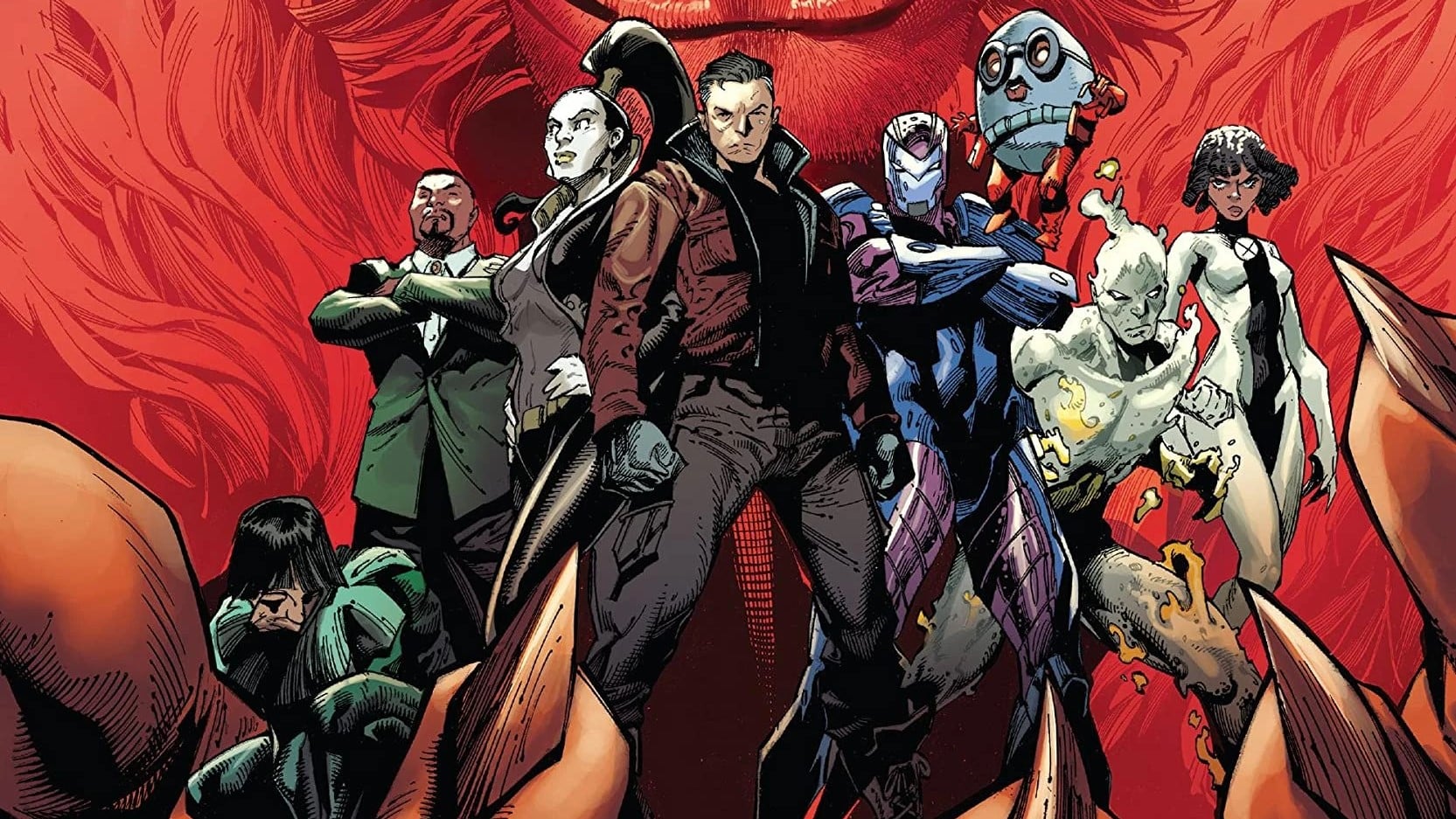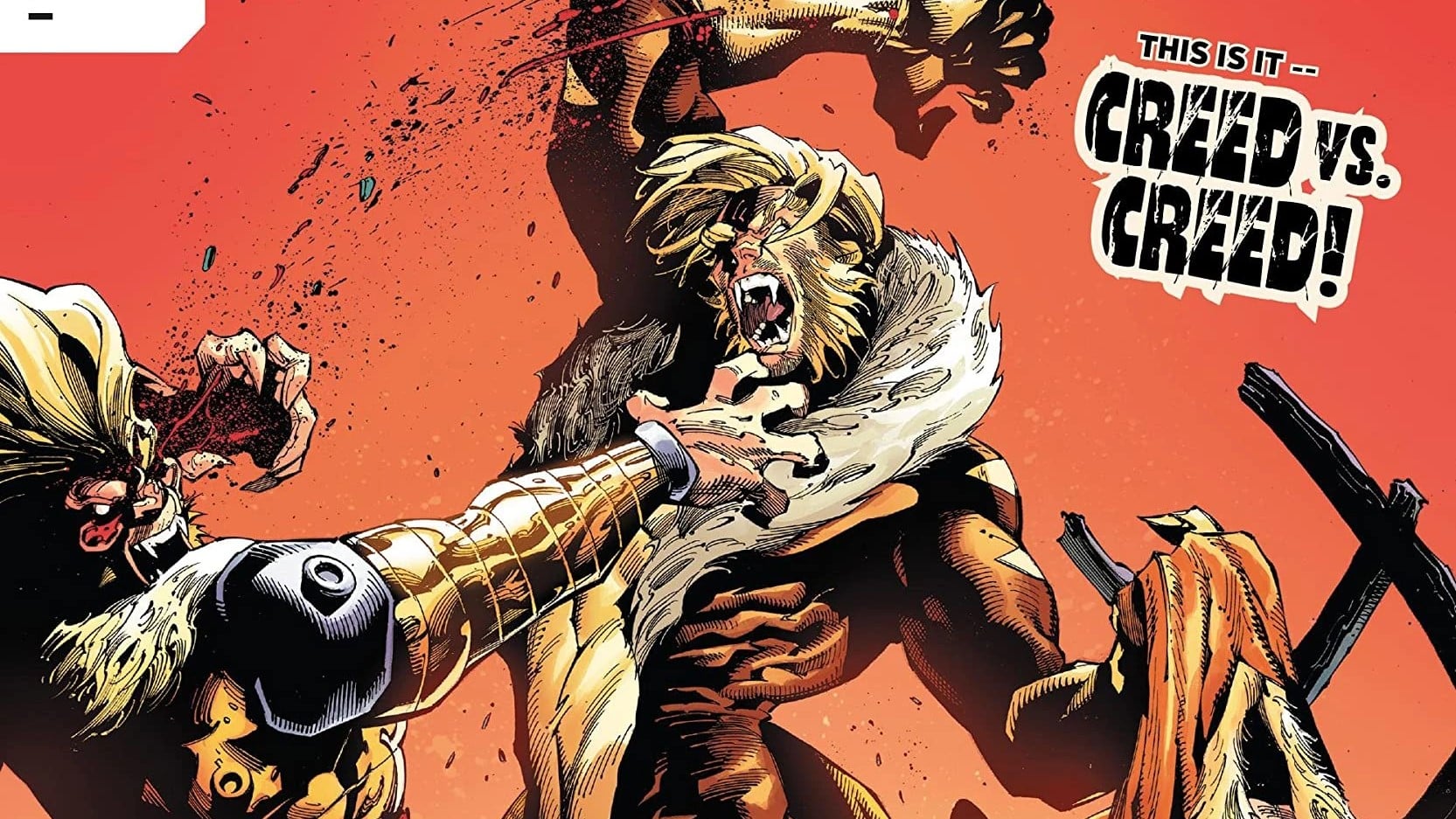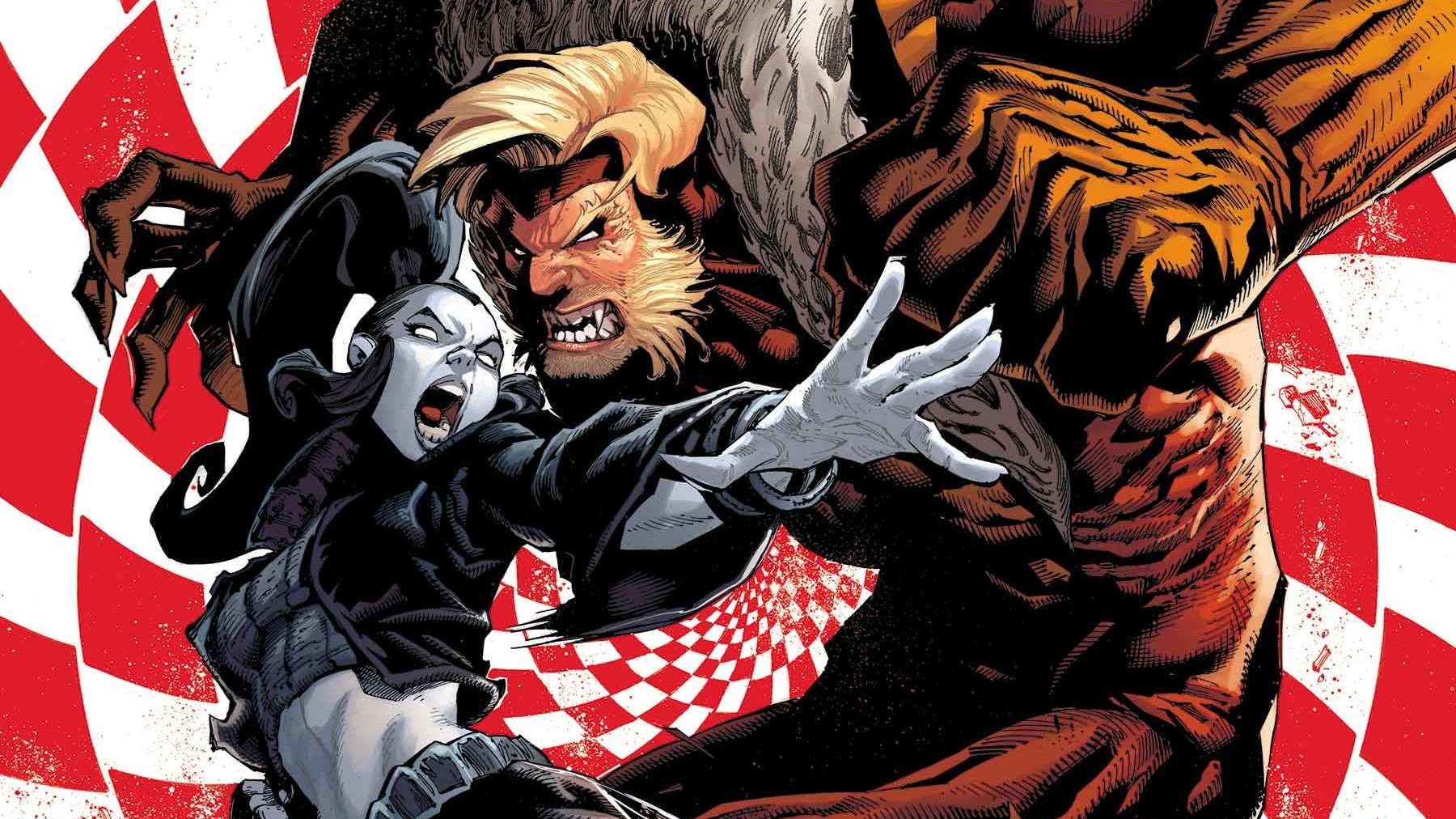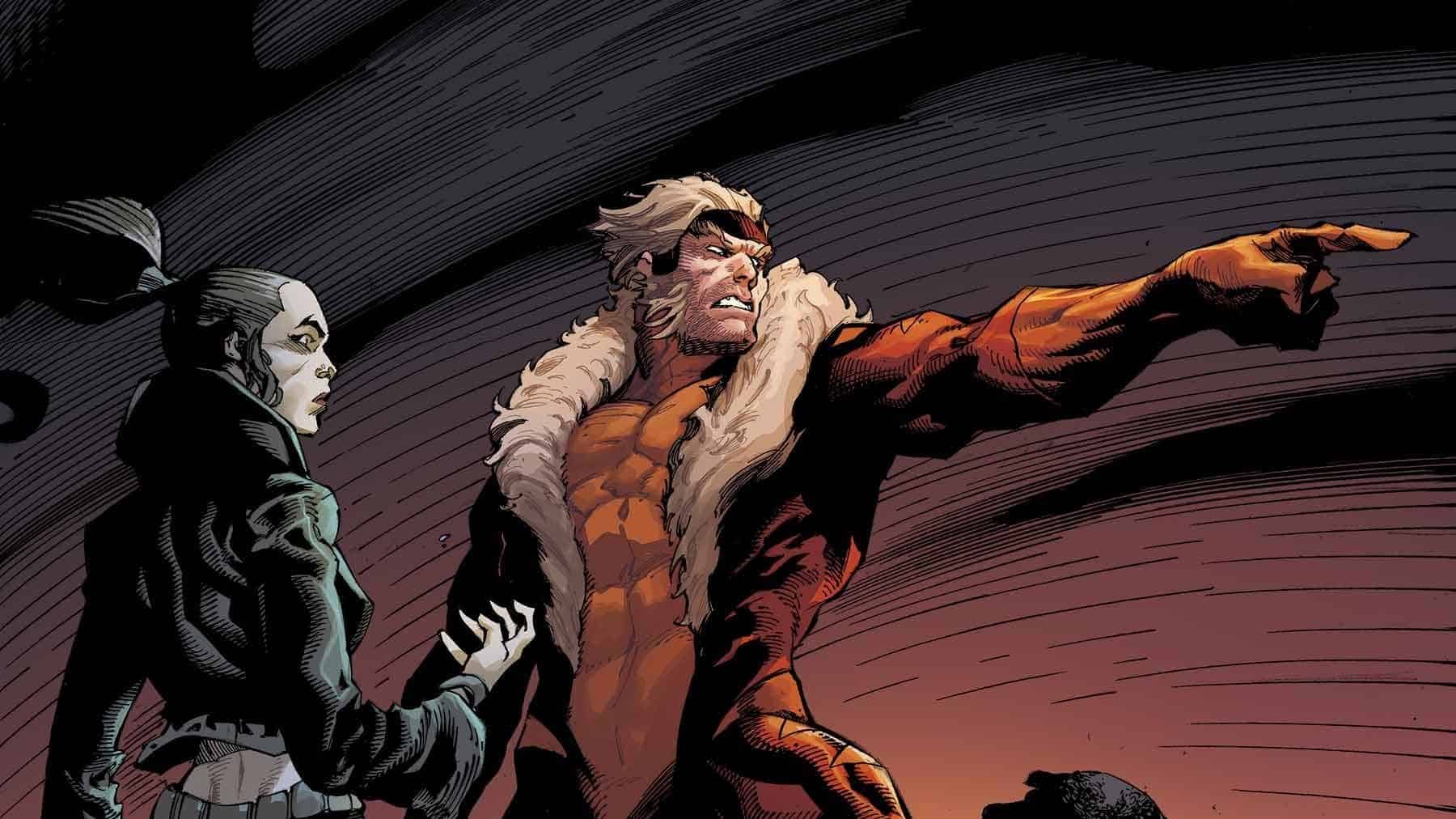Krakoa’s prisoners are out of the Pit but there’s no rest for the weary–or the wicked. Victor Creed has a new jailer and he’ll need the help of his fellow Exiles to save him–and the future of mutantkind–from a fate worse than death. Sabretooth and the Exiles #1 is written by Victor LaValle, drawn by Leonard Kirk, colored by Rain Beredo, and lettered by Cory Petit.
Jude Jones: I’ve lived many lives; in one of them I was a marketing major. I only remember one lesson from those days: everything–everything–communicates something.
Slogans, sure. The dress and language of the actors, of course. But so do more subliminal details, like the appearance of a wedding ring or the hair texture of their kids.
Everything–every single detail–is intentional.
Despite the corporatized, mouse-eared ownership of Marvel Comics, Sabretooth and the Exiles is not (simply) a marketing exercise. It is a sequel to a deeply thoughtful meditation on incarceration and exclusion. It stars a litany of characters, often relegated to the sidelines (literal “c-listers”, as Mole laments). This issue, the first of a(nother) 5 issue run, takes those themes of class and status and asks: what does it mean to live life on the outskirts of what societies deem acceptable? Who protects you? Who advocates for you?
Who fights for your justice?
More than anything, however, Sabretooth and the Exiles is deeply intentional. Maybe that’s obvious. This is art: art requires thought, and thought inherently requires intention.
Yet from images to name drops there is a measured thought to the presentation, not just to arouse our carnal desires, but to actively challenge (challenge!) our thoughts about worthiness and community.
Exiles is an excruciatingly exact and deliberate work that feels laser-focused for my sensibilities.
In other words, this is fucking good.
Anna Peppard: It sure is! I almost hate writing about it because I just want to tell people “go read it,” but I do love talking through all the things the further adventures of Sabretooth make me think and feel, and I think that counts as a review? Plus we get to talk about the history of gynecology this month, and I am definitely down for that.
Jude: Yes, some allusions are very on the nose, and for some this may feel frustrating, like you’re being preached to.
But again, everything about this is intentional; some of us need to sit for a sermon.
How We Got Here.

Jude: Sabretooth was good–so very good–that if you haven’t read it, it is completely worth your time to read it. Now.
Right now.
I’ll wait.
Oh you’re not going to read it now? Fine, I’ll recap:
Sabretooth killed humans. Mutants determined Killing humans is not allowed–after Sabretooth killed humans (a crime many of those who judged him were equally guilty of). Sabretooth was put in The Pit, a jail (of sorts) deep in the bowls of Krakoa. His body was immobilized, but his mind was free to grow increasingly perverted–so much so that his perversion sickened the island. As new bodies were thrown in The Pit (for equally questionable “crimes”), Sabretooth decided to use his connection to Krakoa and the empathy his jailmates would elicit above to escape.
And escape he did, in a stolen boat, off to recruit an army to fight his former captors.
And escape they did, as Doug recognized that keeping anyone in The Pit put the island at risk, and that a free Sabretooth, emboldened with the knowledge of how to control The Pit, and thus Krakoa, was a danger to all.
His former fellow inmates fled Krakoa, in sanguine service to an island (and a people) they no longer feel a connection to, to confront their former tormentor.
Krakoa is not for all mutants; vengeance, however, is for all beings.
We last saw Sabretooth abducted by Orchis. The final pane showed him in a wheelchair, surrounded by a certain type of mutant (I’ll get back to this later), co-opting the language of his oppressor/tormentor to appeal to his new, exiled acolytes.
Now given all of this, there’s a place I thought this story might go, and I’m happy to say I was very, very mistaken. Again, we will get to that later.
Does that about cover it, Anna?
Anna: I’d say so! I didn’t go into this new series with any expectations beyond the expectation it would be good. This first issue fulfills that expectation and reminds me, once again, how deft LaValle and Kirk’s last Sabretooth series was. That series balanced action and comedy and cool sci-fi concepts while doing some of the most careful and intentional work anyone has ever done with the mutant metaphor. Sabretooth and the Exiles #1 is much the same while pushing the story forward in exciting ways that make the wider world of Krakoa-era comics feel both realer and more terrifying. It’s great to see the Exiles out of The Pit.
I know we both know “preaching” and “sermon” are loaded words, but I don’t want our readers to get the wrong idea. Preaching is often associated with didacticism, and as a person who has a complicated relationship with religion, I get that. But I’m pretty sure there’s a version of preaching that’s about encouraging thoughtfulness rather than shunning it—that encourages you to think and see the truth rather than telling you what to think or keeping the truth at bay. To me, LaValle’s injections of historical context feel like that—ways of complicating and reframing a fantasy world that often plays a little too fast and loose with its metaphors. LaValle’s grounding is just that—a strong foundation to build on.
Where We Are.

Jude: I think it’s worthwhile to acknowledge the running theme of this work (and the last): the intentionality and consequences of appearances.
Comic heroes have traditionally been attractive straight-presenting white men. None of our heroes here fit that mold. Two of the white men have willfully altered their appearances to be more in tune with their development as people: Madison Jeffries is now literally the ship they’re riding on, and Melter is now a lava-silverish humanoid. That fully owning their humanity means losing the visage of traditional humanity seems pertinent–as if that visage was limiting, suffocating. (And, given the trans allusions of Madison in the previous run, this makes perfect, beautiful sense.) Orphan-Maker and Nanny are entombed in metal; Toad is hunchbacked and mildly grotesque; Nekra, whose appearance was rooted in the racism of her comic creators, is chalk white; only Third Eye and Oya maintain traditional human looks, and they, intentionally, are both Black.
That scene from Sabretooth I alluded to earlier? Note that all the mutants surrounding him there were also non-traditional: you saw claws and tentacles and horns. Note the first mutant Dr. Harrington operates on looks like Swamp Thing. Note the appearances of the mutants who were in the mass grave–not a “traditional” looking human among them.
This is a group of others and those who have been othered. And Exiles, if nothing else, is here to remind you how others too often get treated.
Creed was apparently test subject number 343. Three hundred and forty three. Thus over three hundred mutants have been abducted and killed by the Nazis, err, Orchis. This begs the question: where was X-Force? The X-Men? Where was Xavier? Did no one know? Did no one care? X-Men #1 began with the rescue of abducted mutants from an Orchis facility; Children of the Atom #4 and #5 (also featuring Dr. Barrington), showed the same.
And of Dr. Barrington, our antagonist: She is a blonde haired, green eyed, traditionally attractive white woman. According to her data page/soliloquy, she bounced from prestigious medical school to school, despite her derelict debauchery. This isn’t just a happenstance, or a throwaway statement: this is proof of privilege. She found opportunity after opportunity to cause harm until someone equally sordid found permanent value in her. Her experiment, her “creation,” with his long blond locks and strong jaw, with his ability to fly and shoot lasers from his eyes, looked like an archetypical Superman–maybe more accurately an Uberman.
Poignantly, hundreds of discarded people, people who suffered painful deaths only to be discarded like trash lead to this “Creation.” The allusions to death camps of all kinds is clear; as is the sad reality that some missing people are more important than others.
Remember, they held a funeral for Katherine Pryde. There were no funerals for the 342.
Remember, only Blink! was looking for Oya and Nekra.
Remember what Mole noted in the beginning of the issue: “there’s no justice. There’s just us.”
Just. Us.
Anna: The first thing that popped into my mind after reading your (fabulous) thoughts was the phrase “you’re preaching to the choir” but that would be a really corny thing to say so… A huge reason Nightcrawler became my favorite X-Man was that for a very long time, he was the only character on the team who couldn’t pass for human. His mere presence prompted questions about the mutant metaphor and what it means to be different. And a huge reason I’m often frustrated with modern X-Men comics is that a lot of those ideas haven’t really progressed as much as I’d like. Here we are with this whole dang mutant utopia and the vast majority of the prominent characters are conventionally attractive (white) folks, and Nightcrawler’s holding press conferences explaining to an anxious mutant public that despite his mutations he’s not a monster.
I’m fascinated by the first text page, a narration from Mole about how there are two kinds of stories in the world, the “overstory” and the “understory.” It’s the thesis of the comic at hand and an example of how good LaValle is at stretching the metaphor while still working within it. The mutant metaphor can become appropriative when it does things like restage various civil rights battles with cis straight while people playing all the roles, or when it goes too hard selling mutanthood as a power fantasy, something that makes you better than the flatscans because you can blow up the world with a thought and they can’t.
But Mole’s narration reminds readers, in no uncertain terms—if you were in this world, you probably wouldn’t be Cyclops, Emma Frost, or Wolverine. Because there’s only a few of those and lots of Moles. But then it turns it around again and does the thing that’s so intoxicating about the mutant metaphor and Marvel comics in general, saying—“this story is about you.” And it’s very, very effective. If you’re a mutant with questions about Krakoa or the blind spots of superhero comics in general—this story’s for you.
Jude: I’ve been a big fan of X-Men Red. I think it’s fantastic, though I critiqued the last issue more harshly. I felt the characters were expositioning, not developing. For a few days I thought that maybe my critique was too harsh.
Exiles makes me think that maybe I wasn’t harsh enough.
We’re given very limited time with our large cast, but in that time we see them describe and develop their personalities in less than 3 sentences. We see Oya is sweet; we gather Nekra is not just vengeful, but learned (you should Google Kenyan Nobel Peace Prize winner Wangari Maathai. That’s the intention, after all). Toad is self loathing; Nanny is protective and Orphan Maker child-like and apocalyptically deadly. Madison and Melter don’t get a lot of development here, and Third Eye retains his role as the author’s surrogate. Still, these characters don’t speak in service of the plot; they speak for themselves as people placed in a plot. There’s a marked difference, which speaks to LaValle’s abilities as a writer.
This is just damn good work all around.
Anna: I’m sure I noted this in our last series of reviews but it’s worth restating because it’s also awesome here—the character voices in this comic are so dang good. Like you said, in the midst of all these big ideas, the characters speak for themselves. They address the ideas but they’re not ciphers for them. They’re funny! And tragic! And empathetic! And weird! And angry! And sometimes two or more of those things at once. I remain in awe of Nekra and deeply invested in the relationship between Nekra and Oya. “I’m not as good as them,” says Nekra. “But you could be,” says Oya.
And I am extremely invested in the further transformations of Madison Jeffries. I loved what you said about him above, how he chooses non-human forms here and how it can relate, multitudinously rather than restrictively, to the hints of trans-ness introduced in the previous series. And no one gives him grief for it. They’re just like yeah, this is our friend, sometimes he’s a ship and sometimes he’s a giant robot, it’s cool. Because it is. It is extremely cool.
Where We’re Going.

Jude: And of Sabretooth? Though the namesake of the issue, he’s conspicuously absent for much of the story. His presence in the set up, mirroring Sabretooth, sees the plot motives introduced through his suffering. He’s then absent–an afterthought–until he breaks free from his glass tomb, using his familiarity with pain as a means for escape.
Pain is key here: his ability to survive pain provides Orchis the final piece to finish their “creation.” His ability to withstand it allows him to free himself in the most sadistically honest way: butting his head against his glass tomb, emerging cut, bruised, damaged. Leonard Kirk knows how to illustrate gore with enough restraint to be descriptive without being superfluous. Excellent work.
Pain is the connecting tissue of all the characters in this book: the Exiles are recovering from the physical and psychological pain of leaving Krakoa and being alone with themselves and their choices; Sabretooth is surviving the physical pain or experimentation, a pain that killed at least 342 mutants before him; the Creation can barely remember who he is over the pain involved in his creation. And Dr. Barrington?
The pain of others is simply a price to be paid by those others for progress.
Anna: Dr. Barrington’s cover letter discussing J. Marion Sims and the extremely racist history of gynecology is certainly extremely intentional, and I am extremely here for it. It’s genuinely informative about stuff I know a lot of people don’t know. (I teach cultural histories of gender and sexuality, and a big part of that job is blowing people’s minds about basic facts they were never told and/or actively discouraged from knowing.) And the intersections of reality and metaphor are once again handled so deftly. LaValle grounds this fantastical story about prejudice, rebellion, and power in real histories then uses more fantasy to make the history realer. When Dr. Barrington switches from decrying racism against Black people to embracing racism against mutants she sounds like every white woman who’s ever said she’s a feminist but only extends sisterhood to fellow white women (and straight women and cis women). This cartoonish villain becomes entirely real by illustrating the really cartoonish nature of so much flesh-and-blood villainy, which would be laughable if the people doing it didn’t believe their own bullshit smells great.
Jude: Pain, I should add, is also shared by the reader. Or at least this reader. The discarding of the others; the othering of those who should be kin; the question of if my home is really mine: this is affecting work, and I appreciate LaValle’s willingness to just go there. Again, many allusions are telegraphed directly: that’s a good thing. A necessary thing. Let there be no confusion about what this work is about. It’s clear. It’s direct.
It’s intentional. And we are all the better for it.
Read this book.
X-Traneous Thoughts

- The lackeys allude to a GC. GC apparently stands for General Contractor. But look at Sabretooth’s face when he takes a look at the ship’s logs before evacuating. I wonder if another GC–Greydon Creed–isn’t involved somehow.
- Madison Jeffries becoming a mech is good! Madison Jeffries’ metal skin resembling the colors of the transgender pride flag is, again, intentional. I appreciate that clarity, especially from a character who seems to have transcended the need for a gendered form.
- “At the risk of seeming ridiculous, let me say that the true revolutionary is guided by great feelings of love.” – Che Guevara (and, apparently, Oya). The complete reimagining of Nekra continues to be beautiful. Keep going.
- The liver, for all of us that need a reminder, metabolizes nutrients to be used by the body or excreted as waste. It determines what’s useful and what to discard. An apt analogy for a work about who society considers useful and disposable.
- I appreciate the self awareness of how big the Orchis ship is, and how the nameless, man-made island of death is the literal antithesis of the living island Krakoa.
- J. Marlon Sims is bad, yes; but remember those ideologies haven’t exactly died out. Not just in the pages of Sabretooth, but in our world as well. Believe Black Women.







